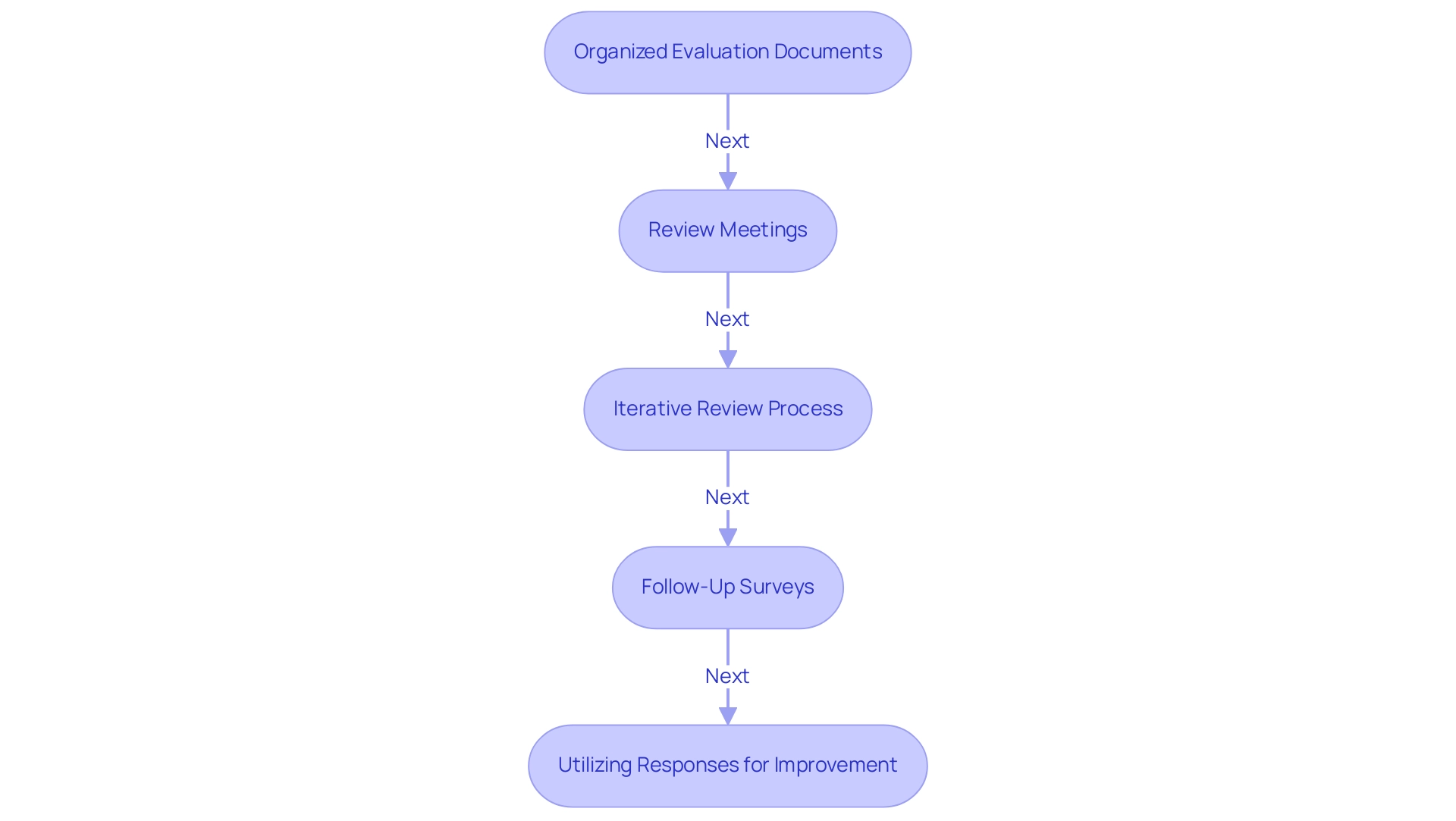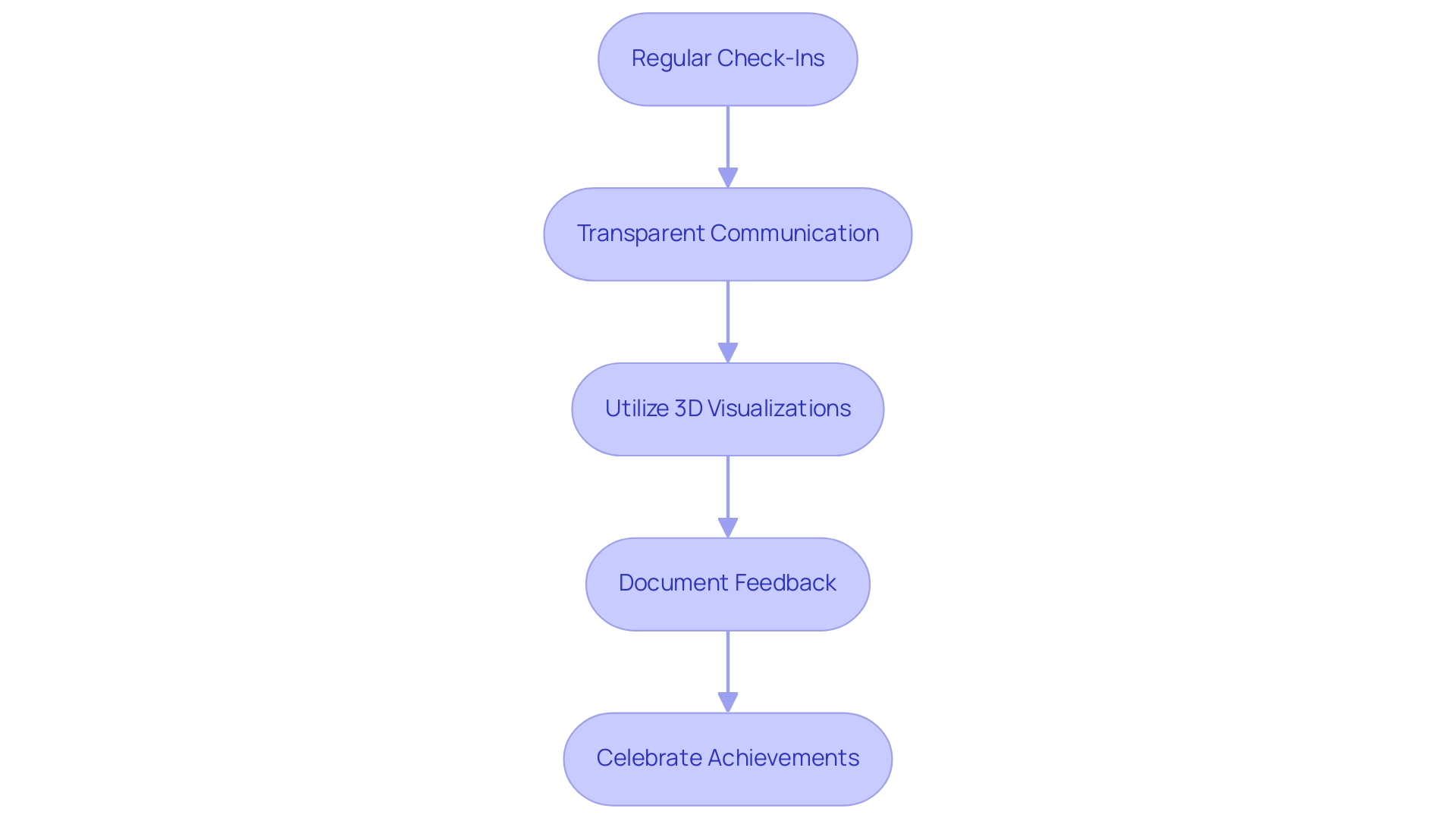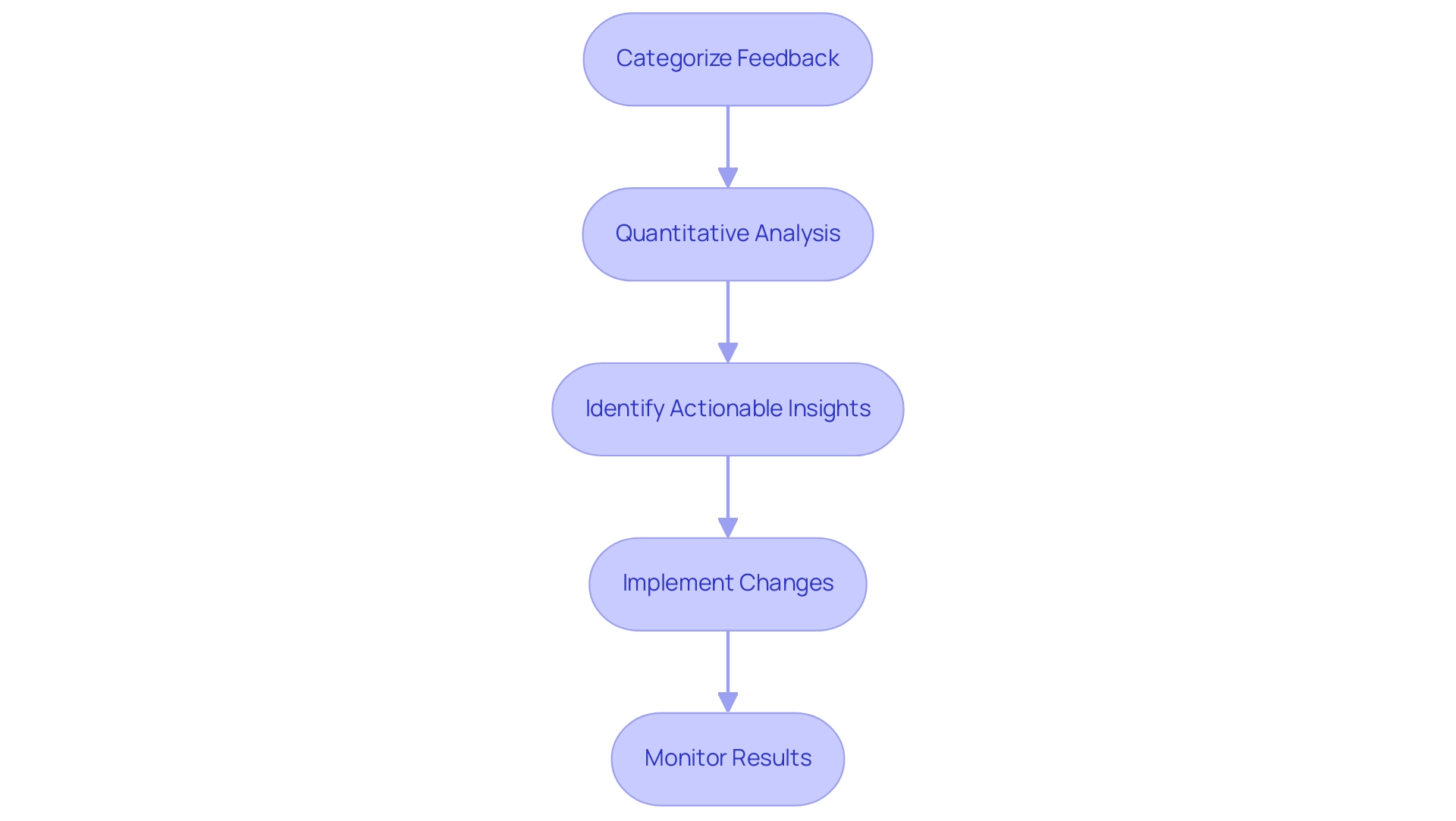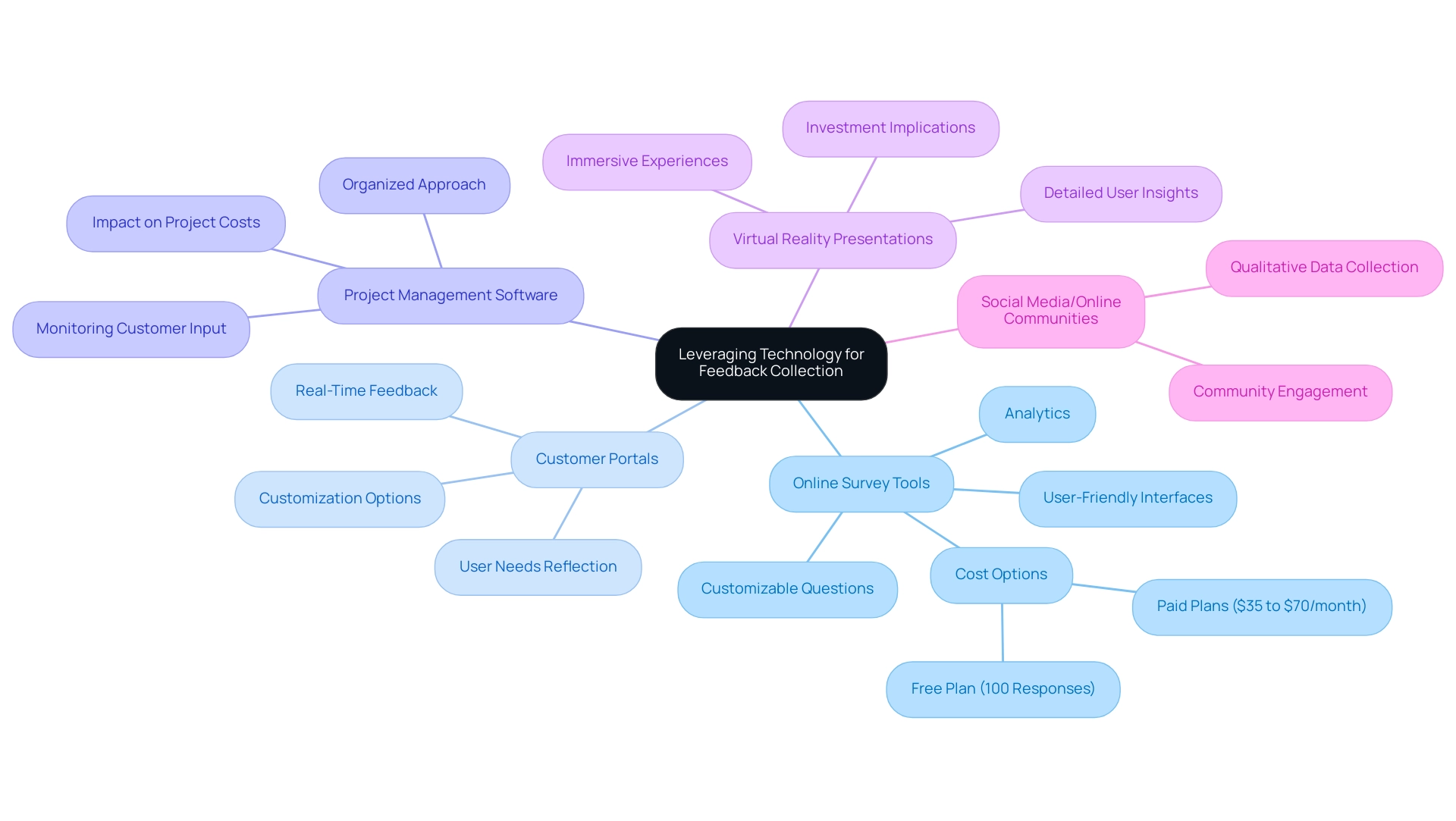Introduction
In the realm of architectural rendering, the integration of customer feedback is not merely a supplementary aspect; it is a cornerstone of the design process that significantly influences project outcomes. Engaging clients through structured feedback mechanisms allows for a deeper understanding of their expectations, preferences, and the nuances that define their vision.
This article delves into the multifaceted strategies for collecting and effectively utilizing client feedback, exploring the iterative nature of communication that fosters collaboration and enhances satisfaction. By examining the critical importance of feedback loops, the role of technology, and the analysis of client insights, architectural firms can refine their rendering practices and ensure that the final product not only meets but exceeds client aspirations.
The Importance of Customer Feedback in Architectural Rendering
Customer opinions are a crucial component in the architectural rendering process, providing architectural rendering customer feedback that offers essential insights into customer satisfaction and areas ready for improvement. At J. Scott Smith Visual Designs, incorporating architectural rendering customer feedback in sessions clarifies their expectations and preferences while highlighting any discrepancies between their vision and the rendered output. For instance, in a recent project, a customer envisioned a vibrant living space and requested modifications in lighting to better reflect the atmosphere they desired.
This iterative process ensures that the final product resonates closely with the initial vision. The importance of our joint planning process is emphasized by the essential conversations we maintain with customers regarding architectural rendering customer feedback. For instance, one customer remarked, ‘The team genuinely grasped my vision and made changes that realized my ideas,’ demonstrating how their thorough feedback directly impacts the scope and implementation of tasks.
Furthermore, favorable comments from past customers, such as ‘The visuals surpassed my expectations and assisted in selling my property swiftly,’ not only strengthen our reputation but also emphasize the value of architectural rendering customer feedback in fostering an environment where constructive critique can lead to ongoing development and innovation. Acquaintance with various outputs—such as high-resolution images, 3D models, animations, and virtual reality experiences—allows customers to assess architectural visualization costs efficiently while ensuring alignment with their objectives. Together, these elements emphasize the significant influence of architectural rendering customer feedback on architectural project results and underscore the essential role of customer involvement in enhancing architectural visuals at J. Scott Smith Visual Designs.
Strategies for Collecting and Utilizing Customer Feedback Effectively
To effectively gather and utilize customer insights in architectural visualization, the following strategies are essential:
- Organized Evaluation Documents: Create detailed evaluation forms for customers to fill out after reviewing the visuals. These forms should incorporate targeted questions regarding realism, design accuracy, and overall impression. This structured methodology facilitates the collection of detailed insights from architectural rendering customer feedback, ensuring no critical aspect is overlooked.
- Review Meetings: Arrange individual review meetings with customers to participate in direct conversation about their thoughts. This personal interaction can unveil insights not captured in architectural rendering customer feedback, allowing for prompt clarification of any misunderstandings and fostering a deeper relationship while ensuring alignment with their vision.
- Iterative Review Process: Introduce an iterative review process that encourages customers to provide feedback at various stages of the rendering. This method keeps participants actively engaged in the endeavor and allows for prompt modifications based on their architectural rendering customer feedback prior to completion, ensuring that their vision is correctly reflected in the final design.
- Follow-Up Surveys: Upon completion, distribute follow-up surveys to assess long-term client satisfaction. This input is invaluable for informing future projects and identifying common themes or recurrent issues that may arise, thus enhancing the overall quality of architectural rendering customer feedback.
- Utilizing Responses for Improvement: Perform a thorough analysis of the collected responses to discern patterns or prevalent concerns. Utilize this data to improve visualization methods, enhance customer communication strategies, and modify your service offerings accordingly. By consistently evaluating and enhancing procedures according to architectural rendering customer feedback, architectural firms can ensure ongoing advancement and increased satisfaction in the visualization process.
Incorporating high-quality visual presentations not only acts as a glimpse into the future of the project but also plays a crucial role in decision-making and generating enthusiasm around the designs. These renderings evoke emotions and resonate with clients’ lifestyles, making the design process more relatable and engaging. Furthermore, with social media’s expanding impact on customer service, integrating these platforms into information collection can offer new opportunities for engagement and insights. Celebrating positive responses within teams can motivate and foster a culture of appreciation, enhancing service delivery. Automation in follow-ups—akin to how MailChimp saved 48,000 agent replies in a year—can simplify response processes, allowing for more efficient data collection and analysis. This ongoing gathering and application of insights is crucial for addressing changing customer requirements and ensuring that the architectural vision aligns with users, especially through the thoughtful consideration of aspects like texture and light in the rendering process.
Creating a Feedback Loop with Clients
To create a productive response system with customers while utilizing 3D architectural visualizations, implement the following steps:
Regular Check-Ins: Arrange consistent meetings throughout the lifecycle to discuss progress and seek initial input. This proactive strategy not only aids in recognizing potential issues early but also showcases your dedication to customer satisfaction. Research indicates that regular communication can significantly enhance success rates, as 80% of office workers prefer immediate feedback rather than delayed responses. This preference underscores the necessity of regular check-ins to ensure clients feel valued and informed.
Transparent Communication: Foster transparency regarding timelines, challenges, and necessary adjustments. Clients who are informed about the status tend to develop greater trust in your expertise, leading to stronger relationships. Current trends indicate that 73% of business leaders prioritize reliability and ease of integration in management solutions. In the architectural context, these factors are crucial for customer satisfaction, as they directly influence how individuals perceive the efficiency and effectiveness of your management strategy.
Utilize 3D Visualizations for Collaborative Design: Incorporate iterative images based on customer feedback during the design phase. By visualizing and validating design ideas through initial renderings, you provide clarity and improve communication, allowing stakeholders to engage more deeply with the work. This collaborative approach not only resolves design issues early but also streamlines workflows, ensuring a smoother process.
Document Feedback: Maintain a comprehensive record of all feedback received, including customer preferences and concerns. This documentation acts as a valuable guide for future endeavors and ensures consistency in your rendering approach. By systematically addressing customer feedback, you can bridge the gap between expectations and delivery, reinforcing the trusted partnership with J. Scott Smith Visual Designs, which has been a leader in the field for over two decades.
Celebrate Achievements: Recognize and convey successful results obtained from customer input. Sharing these successes not only strengthens the relationship but also encourages further collaboration in the future. Acknowledging the contributions of customers cultivates an atmosphere of mutual respect and collaboration—crucial for long-term success.
Partner with J. Scott Smith Visual Designs to visualize and validate your architectural design concepts and experience the transformative power of our detail-driven 3D visualizations. Contact us today to schedule a consultation and see how we can help bring your design concepts to life.
Analyzing and Acting on Feedback
To effectively evaluate and respond to customer input in architectural visualization projects, consider the following structured approach:
Categorize Feedback: Systematically sort feedback into relevant categories, such as design elements, technical accuracy, and overall client satisfaction. This classification is essential for identifying trends and prioritizing areas for improvement, ultimately enhancing the architectural rendering customer feedback regarding your visuals. High-quality renderings act as a window into the future of your project, allowing stakeholders to visualize potential outcomes clearly.
Quantitative Analysis: Where applicable, quantify responses using ratings or scores derived from customer surveys. This quantitative data offers a comprehensive overview of client satisfaction levels and pinpoints specific areas that require attention. Significantly, companies excelling in user experience have shown an impressive capability to exceed the S&P 500 index by 35%—a testament to the financial impact of efficient evaluation management. Additionally, with UX designers projected to see a 16% growth rate in 2024, the demand for skilled professionals in this area is rapidly increasing, underscoring its importance in architectural projects.
Identify Actionable Insights: Scrutinize the feedback for actionable insights. For instance, if many customers express concerns regarding a particular rendering technique, prioritize architectural rendering customer feedback to enhance your future projects. This proactive method not only tackles customer concerns but also cultivates trust and loyalty. Furthermore, 94% of consumers prioritize easy navigation as the most important feature in digital platforms, while 83% consider a beautiful and updated UX design essential. These insights highlight how effective architectural rendering customer feedback contributes to client satisfaction and understanding.
Implement Changes: Following the identification of insights, implement the necessary changes in your production process. This may involve adopting advanced software, refining technical techniques, or improving communication strategies. Preliminary conceptual illustrations can be particularly beneficial here, as they allow for quick visualizations, cost-effective exploration, and support an iterative design process. These renderings facilitate communication among stakeholders, ensuring everyone is aligned on the vision and enhancing early-stage decision-making. The Deloitte report emphasizes that even slight improvements, such as increases in mobile site speed, can significantly correlate with better funnel advancement, showcasing the critical role of prompt action on customer feedback.
Monitor Results: After implementing the changes, closely monitor the outcomes in subsequent projects to evaluate the effectiveness of the adjustments made. Continuous monitoring is essential to ensure that your practices adapt and evolve in alignment with client expectations and prevailing industry standards. With the UX market projected to grow from USD 451 million in 2024 to USD 1,083 million by 2027, the emphasis on continuous improvement in user experience becomes ever more crucial in maintaining a competitive edge. Client testimonials regarding the effectiveness of high-quality renderings can further validate your approach, demonstrating the tangible benefits experienced by stakeholders.
Leveraging Technology for Feedback Collection
To effectively leverage technology for collecting feedback in architectural projects, consider the following strategic tools and methods:
Online Survey Tools: Platforms such as Typeform, SurveyMonkey, and Google Forms are invaluable for creating tailored surveys. These tools not only facilitate the customization of questions but also enable efficient data collection. Typeform, for instance, offers a free plan allowing for 100 responses, with paid options ranging from $35 to $70 per month, providing scalable solutions for varying project sizes. Importantly, these tools feature user-friendly interfaces, integration capabilities with other software, and detailed analytics, enhancing their effectiveness in gathering actionable insights.
Customer Portals: Establishing customer portals enables users to provide input directly on renderings. This interactive approach encourages real-time reactions, boosting involvement and ensuring that feedback is relevant within the environment. Customization options in these portals can be tailored to suit unique specifications, thus reflecting user needs accurately. Such customization can significantly influence the overall investment in a rendering project, as it ensures that customer expectations are met precisely.
Project Management Software: Tools such as Trello or Asana act as efficient platforms for monitoring customer input and action items. By systematically recording all customer remarks, these tools guarantee that no input is overlooked, promoting a more organized approach to customer relations. The capability to adjust details based on input highlights the significance of a cooperative method in attaining customer satisfaction. Furthermore, the level of detail required in these revisions can directly impact project costs, highlighting the need for clear communication about investment implications.
Virtual Reality (VR) Presentations: Utilizing VR technology in presentations for customers can create immersive experiences that promote thorough responses. Clients can engage with visuals in a virtual environment, offering insights that are frequently more nuanced than conventional feedback methods. This high level of detail not only enhances the user’s experience but also highlights the dedication to quality and precision in the rendering process, which can influence the overall investment due to the increased time and resources needed.
Social Media and Online Communities: Engaging customers through social media platforms or dedicated online forums can yield rich qualitative data. These broader engagement strategies allow clients to share their experiences and opinions, fostering a sense of community around your work and providing valuable insights for future projects.
A pertinent case study is Wootric, a customer response tracking software that utilizes NPS, CSAT, and CES surveys to assess customer satisfaction across various channels. Wootric’s intuitive interface facilitates the collection of responses, although it may experience slow loading times with large data sets. This example demonstrates how effective evaluation tools can improve customer satisfaction in architectural contexts, particularly when customization and detail levels are taken into account in the evaluation process.
Incorporating these technology tools not only streamlines the review process but also enhances the quality of client interactions, ultimately leading to more successful architectural outcomes. As mentioned by IT Consultant Giuseppe Sanero, “Assessing the success of a system architecture initiative using input is crucial to determine whether goals have been met.” This sentiment underscores the critical role of effective feedback collection in achieving project goals while emphasizing the significance of customization and detail in rendering projects, which directly correlate with investment considerations.
Conclusion
The integration of customer feedback into the architectural rendering process is not just beneficial; it is essential for achieving optimal project outcomes. By employing structured feedback mechanisms, architectural firms can gain valuable insights into client expectations, preferences, and areas for improvement. The iterative nature of feedback loops, facilitated through direct communication and technological tools, fosters collaboration that enhances client satisfaction and ensures the final renderings align closely with the envisioned designs.
Implementing effective strategies for collecting and analyzing feedback, such as:
- Structured forms
- One-on-one sessions
- Follow-up surveys
empowers architects to refine their rendering practices continually. The incorporation of advanced technology, including online survey tools and virtual reality presentations, further amplifies the ability to engage clients and gather nuanced insights that can inform design decisions.
Ultimately, the commitment to a feedback-centric approach not only cultivates trust and transparency between architects and clients but also drives innovation within the field. As architectural rendering evolves, leveraging client feedback will remain a cornerstone in delivering exceptional designs that resonate with client aspirations, thereby ensuring sustained success in a competitive landscape.





0 Comments